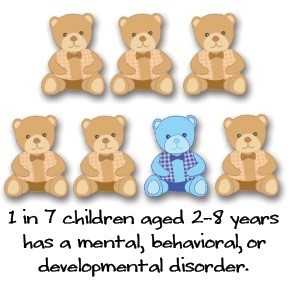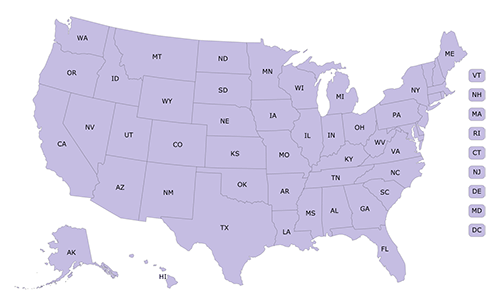Data & Statistics
Mental, behavioral, and developmental health of children aged 2 – 8 years

Parent-reported information from the 2011-12 National Survey of Children’s Health showed that 1 out of 7 U.S. children aged 2 to 8 years had a diagnosed mental, behavioral, or developmental disorder (MBDD). Many family, community, and health-care factors were related to the children having MBDDs.
- Children with the following characteristics were more likely to have a MBDD:
- Boys
- Children age 6 to 8 years
- Non-Hispanic white children
- Children were more likely to have a MBDD if they were from
- poor families (those living at less than 100% of the federal poverty level) and
- families that spoke English in the home
Mental health of children aged 3 – 17 years
The first mental health report that describes the number of U.S. children aged 3–17 years who have specific mental disorders used data collected from a variety of data sources between the years 2005-2011. Analysis of the data showed the following results:
Children aged 3-17 years were identified as having a current diagnosis of
- Attention-deficit/hyperactivity disorder (ADHD) (6.8%)
- Behavioral or conduct problems (3.5%)
- Anxiety (3.0%)
- Depression (2.1%)
- Autism spectrum disorder (1.1%)
- Tourette syndrome (0.2%) (among children aged 6–17 years)
Adolescents aged 12–17 years were identified as having a current diagnosis of
- Illicit drug use disorder in the past year (4.7%)
- Alcohol use disorder in the past year (4.2%)
- Cigarette dependence in the past month (2.8%)
Suicide, which can result from the interaction of mental disorders and other factors, was the second leading cause of death among adolescents aged 12–17 years in 2010.
Read more about this report on children’s mental health
Access to mental health treatment
Early diagnosis and appropriate services for children and their families can make a difference in the lives of children with mental disorders. Access to providers who can offer services varies by location. CDC is working to learn more about access to behavioral health services and supports for children and their families.

Data sources for mental health and related conditions
There are many different datasets which include information on children’s mental health and related conditions for children living in the United States.
Autism and Developmental Disabilities Monitoring (ADDM) Network
The ADDM Network provides data on the proportion or percentage of 8-year-old children with Autism Spectrum Disorder (ASD) and other developmental disabilities in different communities in United States.
National Health and Nutrition Examination Survey (NHANES)
NHANES assesses health and nutritional status through interviews and physical examinations. Collected data covers conditions, symptoms, and concerns associated with mental health and substance abuse, as well as mental health service use and need.
National Health Interview Survey (NHIS)
NHIS collects data on children’s mental health and mental disorders, such as ADHD, autism spectrum disorder, depression and anxiety problems, as well as mental health service use and need.
National Survey of Children’s Health (NSCH)
NSCH examines the health of children, with emphasis on well-being, including medical homes, family interactions, health of parents, school and after-school experiences, and safe neighborhoods.
National Survey of Children with Special Healthcare Needs (NS-CSHCN)
NS-CSHCN assesses whether children with special health care needs have medical homes, adequate health insurance, and access to needed services. Data include report of emotional, behavioral, and mental disorders, as well as mental health service use and need.
National Survey on Drug Use and Health (NSDUH)
NSDUH provides national and state-level data on the use of tobacco, alcohol, and illicit drugs (including non-medical use of prescription drugs) and data on mental health in the United States.
National Youth Tobacco Survey (NYTS)
NYTS is a nationally representative school-based survey on tobacco use by public school students enrolled in grades 6-12.
School Associated Violent Death Study (SAVD)
SAVD plays an important role in monitoring trends related to school-associated violent deaths (including suicide), identifying the factors that increase the risk, and assessing the effects of prevention efforts.
School Health Policies and Programs Study (SHPPS)
SHPPS is a national survey assessing school health policies and practices at the state, district, school, and classroom levels. Collected data includes mental health and social service policies.
Web-based Injury Statistics Query and Reporting System (WISQARS)
WISQARS is an interactive database system that provides customized reports of injury-related data.
Youth Risk Behavior Surveillance System (YRBSS)
The YRBSS monitors health-risk behaviors, including tobacco use, substance abuse, unintentional injuries and violence, sexual behaviors that contribute to unintended pregnancy, and sexually transmitted diseases.
References:
- Perou R, Bitsko RH, Blumberg SJ, Pastor P, Ghandour RM, Gfroerer JC, Hedden SL, Crosby AE, Visser SN, Schieve LA, Parks SE, Hall JE, Brody D, Simile CM, Thompson WW, Baio J, Avenevoli S, Kogan MD, Huang LN; Centers for Disease Control and Prevention (CDC). Mental health surveillance among children – United States, 2005—2011. MMWR Suppl. 2013 May 17;62:1-35.
- Bitsko, RH, Holbrook, JR, Kaminski, J, Robinson, LR, Ghandour, R, Smith, C, Peacock, G. Health-care, Family and Community Factors associated with Mental, Behavioral and Developmental Disorders in Early Childhood – United States, 2011-2012. MMWR. 2016 Mar 11; 65(9);221-226
- Page last reviewed: May 5, 2017
- Page last updated: May 5, 2017
- Content source:


 ShareCompartir
ShareCompartir